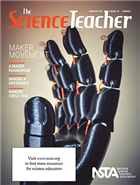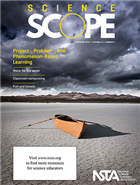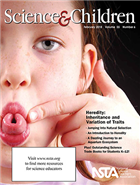Ideas and inspiration from NSTA’s February 2018 K-12 journals
By Mary Bigelow
Posted on 2018-02-12
Regardless of what grade level or subject are you teach, as you skim through the article titles, you may find ideas for lessons that would be interesting your students or the inspiration to adapt/create your own.
All three journals include Outstanding Science Trade Books for Students K–12: 2018. The books are organized by a relevant NGSS Disciplinary Core Idea, with additional correlations to Crosscutting Concepts and Science and Engineering Practices. The reviewers include a grade level range, so you can choose books for students at various reading and interest levels.
 The Science Teacher – Maker Movement
The Science Teacher – Maker Movement
This month’s Editor’s Corner: “Making” a Difference has several points about the Maker Movement. It’s worth a read if you need to convince others of the value.
- Maker education involves problem- and project-based learning through open-ended, collaborative fabrication. Like engineers, makers use an iterative design cycle as they strive to create better solutions. Students solve authentic, personally relevant problems.
- Making has the potential to develop students’ 21st-century skills, such as creativity, critical thinking, innovation, collaboration, and more.
- While maker projects provide students with authentic experiences of science and engineering practices, it can be a challenge to clearly align them with important disciplinary core ideas.
The maker-related lessons described in the articles include connections with the NGSS (including DCIs) and many include classroom resources and illustrations of student work.
- Just as play is important in early learning, Elements of Making discusses how to bring creative experiences to older students. The authors include six elements of making and a related matrix to help us incorporate making into science teaching.
- Grouping Minerals by Their Formulas takes students beyond simply identifying minerals with a 5E lesson in using “mineral formulas to help Earth Science wonder about the connection between elements, compounds, mixtures, minerals, and mineral formulas.” The author includes example of student work in connecting the Periodic Table to mineral properties.
- Not all making involves physical materials. Our Watershed describes a project in which students “use field exploration and online software to design virtual solutions to improve the hydrology of their schoolyard.” Many photographs are used to illustrate the process and the product.
- The author of Going Beyond the X shows how students can probe more deeply into DNA replication through modeling. She includes photos of the partner and group activities.
- Arguing Over Life and Death provides a real-life context (endangered species) for helping students learn, practice, and use a Claim-Evidence-Reasoning framework.
- Career of the Month: Additive Engineer: Who knew that “making” could turn into a career?
- This month’s Library of Congress resource–Right to the Source: Making Old New Again—has a story of students during WWII making model airplanes to aid in training. So… check out the photos–“making” is not necessarily a new thing!
These monthly columns continue to provide background knowledge and classroom ideas:
- Focus on Physics: Electromagnetic Waves and the Speed of Light
- Science 2.0: Drones for the Science Classroom
For more on the content that provides a context for projects and strategies described in this issue, see the SciLinks topics Chromosomes, Conservation of Energy, DNA Replication, Electromagnetic Induction, Electromagnetic Waves, Endangered Species, Mineral Identification, Mineral Properties, Mitosis, River Systems, Watersheds
Keep reading for Science Scope and Science and Children.
 Science Scope – Project, Problem, and Phenomenon-Based Learning
Science Scope – Project, Problem, and Phenomenon-Based Learning
If you’re new to PBL or mentoring someone who is, From the Editor’s Desk: Tips for Project-Based Learning has many tried-and-true suggestions based in the editor’s actual middle school experiences!
Articles in this issue that describe lessons include a helpful sidebar (“At a Glance”) documenting the big idea, essential pre-knowledge, time, and cost; many follow a 5E format. The lessons also include connections with the NGSS, and many include examples of student work, assessments, and classroom materials.
Composting: A Problem, Place, or Project? Using the PBL Trifecta (PBL3) in the Classroom illustrates how a traditional activity can become a powerful experience in combining place-based, problem-based, and project-based learning.
The 5E lesson in Disequilibrium: The Advantages of Biodegradable Products addresses the environmental impact of non-compostable materials.
- Good news! Teachers don’t necessarily have to develop brand-new units to incorporate PBL. The authors of The NGSS-ification of Too Slow to Notice: How to Turn Any Unit into a Phenomena-Based, Student-Driven Investigation provide a planning template and an illustrated “road map” example from their own experience. “Go on, get your hands dirty and do science!”
- Students apply A Framework for Integrating Science, Engineering, and Literacy, using solar ovens and marshmallows.
- Why Do Fishermen Need Forests? Developing a Project-Based Learning Unit With an Engaging Driving Question shows the value of driving question to stimulate curiosity and anchoring phenomena to provide a context. Although the example focuses on aquatic ecosystems, the process could apply to a variety of topics.
- How Can We Provide Water for Developing Countries? 5E Unit Empowers Students to Solve the Global Water Crisis has for getting students to think about and create solutions for a global problem and present their findings.
- Commentary: Codesigning Science Projects With Students discusses how to incorporate “student voice” into PBL as the roles of students and teachers change.
- Add a new dimension to a stream study investigation with Citizen Science: Take a Stream Selfie for Science. Students upload photographs to a monitoring projects sponsored by the Izaak Walton League of America.
- PBL often involves teams of students working together. Science For All: Managing Group Work has ideas for managing groups of students to work cooperatively and productively.
- Making ice cream changes from a cookbook lab to a phenomenon-based lesson, as described in Teacher To Teacher: Teaching With Everyday Phenomena
These monthly columns continue to provide background knowledge and classroom ideas:
- Scope on the Skies: Storms From the Skies
- Listserv Roundup: Note-Taking Strategies in the Science Classroom
For more on the content that provides a context for projects and strategies described in this issue, see the SciLinks topics Biodegradable, Changes of State, Composting, Desalination, Drinking Water Standards, Ecosystems, Heat Transfer, Marine Ecosystems, Meteors, Phases of Matter, Properties of Matter, Water Quality
 Science & Children – Heredity: Inheritance and Variation of Traits
Science & Children – Heredity: Inheritance and Variation of Traits
Editor’s Note: Observing Heredity “Heredity is one of the topics of the greatest interest to elementary children. In many cases, it is a topic that focuses on them. They have likely heard from a very young age that they look like their mother or have their father’s eyes…Simple observations are a good way to start on the pathway of understanding heredity. The Next Generation Science Standards begin the progression of learning about heredity at grade 3. It’s here where students begin to recognize that we have some traits that are not inherited; they are a result of the environment.”
The lessons described in the articles have a chart showing connections with the NGSS and many include classroom materials and illustrations of student work.
With observing live crickets and other activities as a context in Jumping Into Natural Selection, students “tell the story” of changes in populations and develop background knowledge to support a progression toward understanding the process in later grades.
- An Introduction to Heredity: Part 1 has students inventory observable traits and variations in traits, creating graphs and a summary “tree of traits.” An Introduction to Heredity: Part 2 extends the lesson with a focus on how traits are passed from parents to offspring. Both lesson included take-home activities that were also available in Spanish.
- The lesson in A Dazzling Journey to an Aquarium Ecosystem combines hands-on building of small aquariums with digital microscopy (an app on tablets) to observe the inhabitants up close.
- “Put away those paper plates divided into four sections to represent the life cycle of a butterfly, and together with your students, represent the life cycle of the butterfly through writing, drawing, dance, and math and Dance Like a Butterfly.
- Our youngest scientists can begin their study of living things by exploring animals and their offspring. The Early Years: Teaching Life Cycles Throughout the Year has suggestions for doing this.
- Formative Assessment Probes: Uncovering Students’ Ideas About Inherited Traits could be used to discover misconceptions and guide instruction.
- Teaching Through Trade Books: Investigating Heredity has two 5E lessons (K-2 and 3-5) in which students observe and identify physical traits passed from parents to offspring.
- Similarities and differences between lions and house cats are the focus of The Poetry of Science: Comparing Cats
These monthly columns continue to provide background knowledge and classroom ideas:
- Science 101: If Evolution Is Based on “Survival of the Fittest,” Why Do Diseases Such as Cancer and Alzheimer’s Disease Persist in the Human Population?
- Science 102: Tricky Numbers
- Engineering Encounters: Goldilocks and the Engineers
- Methods and Strategies: Drawing for Meaning
For more on the content that provides a context for projects and strategies described in this issue, see the SciLinks topics Aquatic Plants and Animals, Butterflies, Ecosystems, Food Chains, Genetics, Heredity, Insects, Life Cycles, Natural Selection, Traits
Disclaimer: The views expressed in this blog post are those of the author(s) and do not necessarily reflect the official position of the National Science Teaching Association (NSTA).

